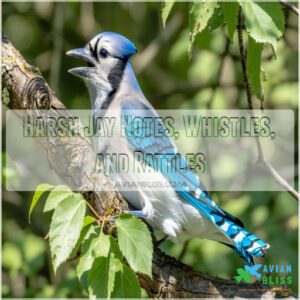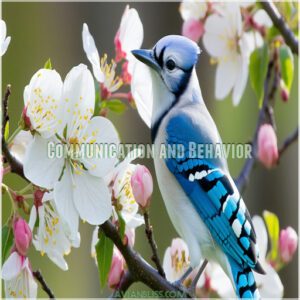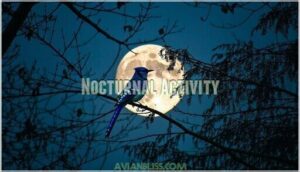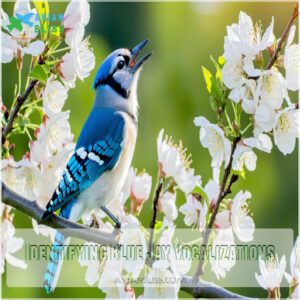This site is supported by our readers. We may earn a commission, at no cost to you, if you purchase through links.
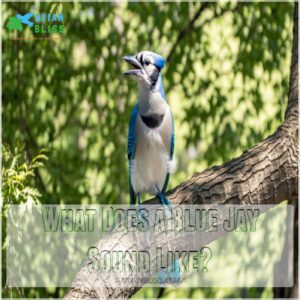 A Blue Jay’s sound is as bold as its feathers.
A Blue Jay’s sound is as bold as its feathers.
You’ll often hear their sharp “jay! jay!” calls, but they’re far from one-note performers.
They mix in whistles, rattles, and even mimic other birds, like hawks, to protect their territory.
Each jay has its own unique voice, almost like a fingerprint, and their calls can vary by region—East Coast jays tend to be faster, while Western ones are more nuanced.
These vocal acrobats use their sounds to defend nests, attract mates, and communicate with their flock.
Curious about how they mimic predators or adapt their calls to defend their territory?
There’s more to explore.
Table Of Contents
- Key Takeaways
- What Does a Blue Jay Sound Like?
- Blue Jay Vocalizations
- Communication and Behavior
- Nocturnal Activity
- Distinctive Sounds and Calls
- Conservation and Protection
- Frequently Asked Questions (FAQs)
- What sounds do Blue Jays make?
- What does it mean when you see a Blue Jay?
- How do you know if a blue jay is a bird?
- What does a blue jay call?
- What kind of noises do blue jays make?
- What does a blue jay squawk mean?
- Is a blue jay aggressive?
- What is mistaken for a blue jay?
- Why do Blue Jays scream at night?
- What bird sounds similar to a Blue Jay?
- Conclusion
Key Takeaways
- You’ll hear Blue Jays making sharp "jay! jay!" calls, whistles, and rattles, often mimicking hawks to protect their unique voice.
- Each Blue Jay has a unique voice, and their calls can vary by region, with eastern jays being faster and western ones more nuanced sounds.
- They use their vocalizations to defend nests, attract mates, and communicate with their flock, showcasing their intelligence and social nature.
- Blue Jays adapt their sounds to different situations, like loud alarms during danger or soft songs for courtship and bonding.
What Does a Blue Jay Sound Like?

A blue jay’s vocalization patterns are unmistakable, featuring a sharp, piercing "jay! jay!" call that echoes through forests and backyards.
Alongside this, you’ll hear whistles, rattles, and even subtle call variations, including mimicry of other birds.
One theory suggests hawk mimicry benefits nest protection.
If you’ve ever wondered, “What does a blue jay sound like?”—it’s bold, loud, and impossible to ignore.
Blue Jay Vocalizations
When you hear a Blue Jay, you’ll be struck by its loud, distinctive calls that range from harsh jeers to melodic whistles.
These remarkable birds aren’t just noisy neighbors; they’re sophisticated vocal artists who can mimic other bird species and communicate complex messages through their remarkable repertoire of sounds.
Harsh Jay Notes, Whistles, and Rattles
When you hear a blue jay, you’re in for an acoustic adventure that’ll make your ears perk up.
Their vocal learning skills allow them to create a symphony of whistles and rattles that range from piercing alarms to complex sound patterns that’ll stop you in your tracks.
These feathered maestros blast out harsh "jay" calls that slice through the backyard soundscape with razor-sharp precision.
Mimicking Other Bird Species
Nature’s sound artists, jays crack the code of vocal imitation.
They’ll mimic hawk calls to scare off competitors, turning sound into a survival tactic.
Jays’ mimicry also serves essential social functions, as explored on this blue jay mimicry webpage.
From Red-shouldered Hawks to woodpeckers, these feathered impersonators can trick other birds, protecting their territory and food sources with nothing more than a well-timed screech.
Regional and Individual Variations
Ever wondered why blue jays in your backyard sound different from those in distant woods?
Geographic call patterns reveal a fascinating world of vocal diversity.
Each jay develops a unique acoustic signature, with regional dialects as distinct as local accents.
You can explore a collection of their vocalizations at the Cornell Lab of Ornithology.
From the East Coast’s rapid-fire calls to Western regions’ more nuanced tones, these birds showcase incredible vocal learning processes that let them recognize each other and adapt to their specific environments.
Communication and Behavior
You’ll want to listen carefully when blue jays communicate, as their complex vocal behaviors reveal fascinating insights into their social interactions.
These intelligent birds use a remarkable array of calls, whistles, and mimicry to defend territories, attract mates, and coordinate with their flock members.
Territorial Defense and Mate Attraction
When blue jays release their vocal arsenal, they’re not just making noise—they’re declaring war on potential intruders and wooing potential mates.
Their strategic communication toolkit includes:
- Territorial markers that scream "Back off!"
- Piercing defense strategies that echo through forests
- Mesmerizing courtship rituals that attract partners
These feathered maestros transform sound into a powerful weapon of survival and seduction.
Social Behavior and Flock Dynamics
In noisy flocks, blue jay sounds reveal their complex group dynamics.
Through blue jay vocalizations and displays like wing-fluttering, they establish a dominance hierarchy, ensuring order during feeding and nesting.
Flock interaction strengthens social learning, helping detect predators and share resources.
Blue jays’ territorial disputes often feature sharp calls, showing how they communicate and maintain cooperative breeding in shared spaces.
Courtship Rituals and Displays
Watching blue jays during mating season reveals fascinating display rituals.
Males perform bowing and wing-fluttering to impress females.
They may bring gifts, like acorns or berries, as part of pair bonding.
These elaborate courtship displays communicate readiness to mate, as detailed on the bird behavior mating rituals page.
Body language, such as aggressive postures, plays a role in sexual selection.
Meanwhile, blue jay courtship calls and soft songs enhance their appeal, showcasing the complexity of blue jay vocalizations.
Nocturnal Activity
Blue Jays are mostly quiet at night, but they may call out if disturbed or threatened. Their nocturnal sounds can alert other animals to predators or unexpected activity.
Reasons for Vocalizing at Night
At night, blue jays use vocalizations to guarantee survival and maintain order.
Their Nighttime Warning Calls alert others to predators, while Nocturnal Territorialism defends resources.
These Dark Hour Songs also strengthen pair bonds and attract mates.
Curious about the blue jay sound at night? Check out the table below:
| Reason | Purpose |
|---|---|
| Predator Alerts | Warn others of danger. |
| Territorial Defense | Keep intruders away. |
| Mate Communication | Attract or bond with mates. |
| Midnight Chirping | Signal food or safety. |
Impact of Nocturnal Behavior on Nearby Species
Blue jay noises at night can affect nearby nocturnal species in several ways:
- Nighttime foraging attracts predators, disrupting the ecosystem balance.
- Loud blue jay vocalizations create noise pollution, impacting species interactions.
- Predator avoidance behaviors in prey species are disturbed by sudden calls.
- Artificial light exposure alters blue jay sounds and calls, disrupting natural rhythms.
Their nighttime habits ripple through ecosystems.
Role in The Ecosystem During Nighttime
How do Blue Jays impact the ecosystem at night?
Their nocturnal foraging aids in seed dispersal, promoting forest growth.
Blue jay vocalizations, like sharp alarm calls, warn of nighttime predators, maintaining ecosystem balance.
Their dark adaptation guarantees survival, while blue jay noises subtly coordinate group behavior.
Curious about what does a blue jay sound like?
Their nighttime calls are essential for silent communication, and their vocalizations help in warning other birds.
Distinctive Sounds and Calls
Blue Jays are known for their loud, varied calls, including harsh "jeer" notes and melodic whistles.
Their ability to mimic other birds and adapt their sounds makes them easily distinguishable in forests and backyards alike.
Description of Typical Vocalizations
Ever wonder about the blue jay sound description? Their vocalization patterns include sharp "jay" calls, melodic whistles, and metallic rattles.
These birds master call variations, mimicking hawks and crafting unique bird songs.
Seasonal shifts influence their sounds—soft courtship tones in spring, piercing alarms in fall.
Through frequency analysis, you’ll uncover their knack for learning and adapting sound waves to communicate.
Identifying Blue Jay Vocalizations
To identify a blue jay sound, focus on their grating "jay" cries, sharp whistles, and nasal tones.
Their "toolool" calls in spring often mimic hawks, showcasing impressive bird mimicry.
A thorough bird songs and calls guide can help differentiate between songs and calls, essential for accurate identification.
Loud squawking signals territorial disputes or mate attraction.
Understanding these vocalization patterns and call variations helps with sound recognition, offering a clear blue jay sound description for precise audio analysis and identification.
Comparison With Similar Bird Species
You might confuse a Blue Jay’s call with other birds, but their raspy, loud vocalizations stand out.
They mimic hawks and even rival crows in complexity.
Compared to similar songbirds, they’re louder than Catbirds and sharper than Mockingbirds.
For detailed comparisons, explore these blue jay vs mockingbird call examples.
Blue Jays dominate bird calls in North America with their range.
- Mimics hawks to scare predators
- Louder than most backyard birds
- Sharp, varied vocalization patterns
- Complex sounds for territory defense
- Unique raspy tone for easy identification
Conservation and Protection
Blue Jays play a pivotal role in forest ecosystems by spreading seeds and maintaining biodiversity. Protecting their habitats guarantees their survival and supports the balance of these environments.
Importance in Forest Ecosystems
In forest ecosystems, blue jays play a pivotal role in biodiversity conservation.
Their actions as seed dispersers support tree regeneration, ensuring forest health.
Their vocalizations, like the distinct blue jay call, often signal changes, aiding ecosystem balance.
By preying on insects and interacting with wildlife, they maintain harmony.
Observing and learning to identify blue jay sounds highlights their importance in sustaining nature’s intricate web.
Threats to The Blue Jay Population
Blue Jays face growing threats that impact their survival.
Habitat loss from deforestation and urban sprawl reduces nesting areas.
Climate change shifts their range, disrupting food sources and migration.
Human impact adds risks like pesticide poisoning and vehicle strikes.
- Predator increase: Cats, squirrels, and raccoons target nests.
- Disease spread: Viral and bacterial infections harm populations.
- Collisions: Man-made structures cause fatalities.
Legal Protection and Conservation Efforts
Thanks to wildlife laws like the Migratory Bird Treaty Act, it’s illegal to harm or capture blue jays without a permit.
Conservation efforts prioritize habitat preservation, reducing deforestation, and controlling pesticide use.
Current bird conservation efforts today also focus on mitigating climate change impacts and promoting sustainable practices.
You can help by supporting environmental policies and creating bird-friendly spaces.
These actions guarantee species protection while aiding in blue jay sound identification and promoting broader wildlife conservation for future generations.
Frequently Asked Questions (FAQs)
What sounds do Blue Jays make?
You’ll hear Blue Jays making loud “jeer” calls, soft whistles, and even mimicking hawks.
Their songs include clicks, chortles, and warbles.
They use these sounds to warn, attract mates, or defend their territory.
What does it mean when you see a Blue Jay?
Seeing a Blue Jay often symbolizes curiosity, intelligence, and communication.
It might remind you to speak up, defend your space, or stay alert.
Their bold presence inspires confidence and resilience in facing challenges.
How do you know if a blue jay is a bird?
You’ll know it’s a bird by its feathers, wings, and ability to fly.
Blue Jays also perch, build nests, and lay eggs, fitting the traits of birds.
Their distinct calls further confirm it.
What does a blue jay call?
A blue jay’s call ranges from loud “jeer” or “jay” sounds to high-pitched whistles and sharp alarm cries.
They mimic hawks, create gurgling noises, and even produce soft, melodic songs during courtship or communication.
What kind of noises do blue jays make?
Blue jays produce a mix of loud "jeer" calls, soft whistles, and gurgling sounds.
They mimic hawks, snap their bills, and even create melodic songs with clicks, whines, and trills, depending on the situation.
What does a blue jay squawk mean?
A blue jay squawking usually signals alarm or warning.
They might’ve spotted predators, like hawks or cats, and are alerting others.
It can also express agitation during territorial disputes or when defending nests.
Is a blue jay aggressive?
A flash of feathers and an attitude to match, a blue jay can be aggressive.
They defend territories fiercely, chase intruders, and mob predators like hawks or owls, protecting their nests and flock with sharp calls.
What is mistaken for a blue jay?
You might confuse a blue jay with a Steller’s jay or a scrub jay.
Their similar size and blue coloring often cause mix-ups, but their behaviors and markings make them easy to tell apart up close.
Why do Blue Jays scream at night?
At night, Blue Jays scream to warn of predators like owls or raccoons.
Their alarm calls alert nearby birds of danger, showcasing their protective instincts and strong group communication even when darkness falls.
What bird sounds similar to a Blue Jay?
A mockingbird often sounds like a Blue Jay since it mimics their calls, including the loud, raspy "jeer".
These skilled imitators pick up bird songs and even mimic hawk cries, blending them seamlessly.
Conclusion
Like a musical puzzle, a Blue Jay’s sound is a mix of sharp calls, softer whistles, and clever mimicry.
Their vocal range is as diverse as their bold behavior, helping them defend territory, attract mates, and communicate with their flock.
These sounds vary by region and individual, making each jay unique.
If you’ve ever wondered, “What does a Blue Jay sound like?” just listen for their distinct calls—they’re nature’s vocal acrobats in action.
- https://www.allaboutbirds.org/guide/Blue_Jay/sounds
- https://play.google.com/store/apps/details?id=com.leafgreen.bluejay&hl=en_US
- https://www.reddit.com/r/whatsthisbird/comments/175uqkt/is_this_a_sound_blue_jays_usually_make/
- https://www.ajc.com/lifestyles/environment/blue-jay-squawking-iconic-sound-fall/B3vz1XgMC0YwpzA9KXHeTJ/
- https://www.birdwatching.com/tips/jaytalk.html

